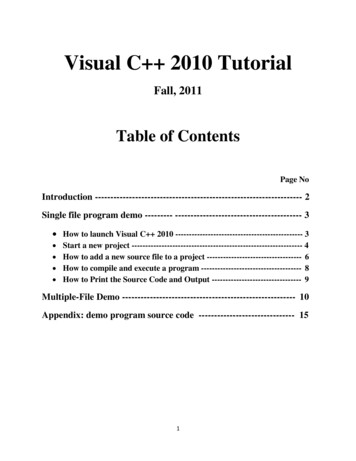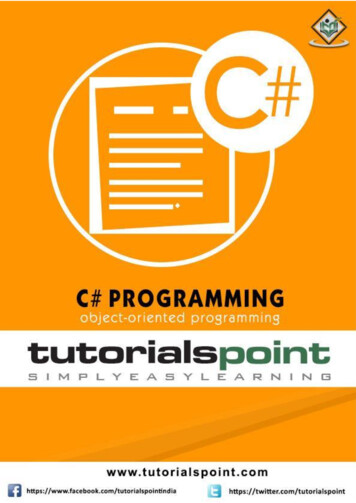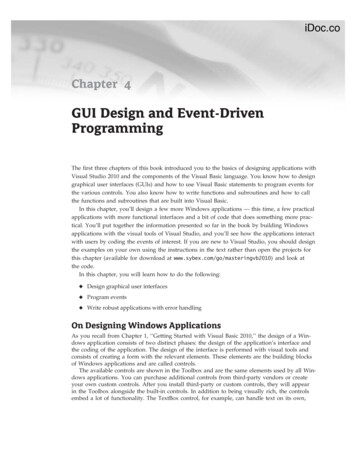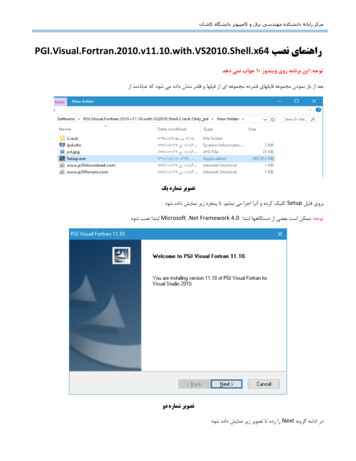
Transcription
Visual C 2010 TutorialFall, 2011Table of ContentsPage NoIntroduction ----------------- 2Single file program demo --------- ----------------------------------------- 3 How to launch Visual C 2010 ----------------------------------------------- 3 Start a new project ------------- 4How to add a new source file to a project ----------------------------------- 6How to compile and execute a program ------------------------------------- 8How to Print the Source Code and Output --------------------------------- 9Multiple-File Demo ------ 10Appendix: demo program source code ------------------------------- 151
Program Development with Microsoft Visual C 2010IntroductionThis tutorial is written to help those who are new to Visual C . It introduces the IntegratedDevelopment Environment (IDE) of Microsoft Visual C 2010 and shows how to enter, edit, save,retrieve, compile, link, and run a C program in such an environment. It also shows a simple wayto print the source code and the program output.Two simple C projects, one single-file and the other multi-file are used as demo programs so thatstudents can focus on Visual C 2010 IDE instead of getting distracted by language features. Forthe convenience of the reader, source code for both programs is listed in the Appendix.If you have any comments and/or suggestions that might help improve the effectiveness of thistutorial, please forward them to either Dr. E. Hu at hue@wpunj.edu or Marvin Kiss atkissm@wpunj.edu.2
Single-file Project: The Hello World ProgramStep 1: Launch the MS Visual C/C 2010 software from task bar. The main window of VisualStudio 2010 should be similar to the below display:Note:1. Hereafter, all system defined terms including menu items such as File will appear in boldand all entries made by programmers such as a filename are italicized.2. If the Solution Explorer window on the left is not shown, click View in the menu bar andthen click Solution Explorer to display it.3
Step 2: In the menu bar, click File New Projects to display the New Project dialog boxshown below:In the New dialog box shown below, select by clicking Visual C in the Installed Templatepane and Win32 Console Application in the middle pane. You then enter a name of yourchoice for the project (e.g., hello world as shown) in the Name box, select the location or folderin which you’d like to store project files (e.g., C:\Users\irwinhu\Documents\CS230\ as shown)by clicking the Browse Note that there is no need to enter a name in the Solution name box;the system fills the project name in it by default.4
Click on the OK button to display the Win32 Application Wizard – hello world window shownbelow:Click the Next button to display the following dialog box:Check the Empty project box as shown above and click on the Finish button to proceed to thenext step.5
Step 3: Now the system displays the following window.Right click on the Source Files folder in the Solution Explorer pane. In the popup menu, clickAdd then New Item to display the following Add New Item – hello world dialog box:Select C Files (.cpp) by clicking on it in the middle pane and enter an arbitrary file name (e.g.,hello world, the same name we used for the project is chosen here). Click Add to proceed to thenext step.6
Step 4: The system displays the below window. Notice that 1) the Source Folder in SolutionExplorer pane (make sure the Solution Explorer instead of Class View tab is selected) containsthe hello world.cpp file that we just added and 2) the blank editing area/board is displayed with ahello world.cpp tab for you to enter your C source code.The same window after the source code is entered:7
Step 5: To compile, link, load, and execute a program in a single step, click Debug in the menubar and the click Start Without Debugging. If there is no error in your project, the belowmessage Build: 1 succeeded, 0 failed, 0 up-to-date, 0 skipped is displayed in the Output window as shown below.Also displayed in a separate window (C:\Windows\system32\cmd.exe) is the program output:8
Step 6: You are normally required to turn in both the source code and the program output inprinted form. One way to do it is to copy the source code from Visual C 2010 and paste itonto a Word document. Immediately after the source code, do a screen capture of the programoutput window (click on the window to activate it, hold down the Alt key and press the PrintScreen key) and paste it on the Word document as shown below.Note that comment statements have been added to the program code as part of the documentationrequirement for a programming project. Check with your instructor regarding programdocumentation and submission rules.9
A Multiple-File Project: The Time ProgramIn this demonstration, the project or program that prints a given time of the day in both militaryas well as standard time formats. The project contains three files created by the programmer: twosource files (timeDemo.cpp and Time.cpp) and a header file (Time.h). Again we’ll build theproject from scratch.Step 1: Launch Visual C 2010, click File New Project to display the New Projectdialog box. In the dialog box, select Visual C in Installed Template pane and Win32Console Applications in the middle pane. Enter project name (e.g., Time in this demo) in theName box and select the folder in which you’d like files for this project to be stored (e.g.,C:\Users\irwinhu\Documents\CS230\ in this demo) by clicking the Browse button as shownbelow:Click OK to display the Win32 Application Wizard – Time dialog box.10
Step 2: In the dialog box, click Next (do not click Finish) and check the Empty project box asshown below:Click Finish to move on.Step 3: Add header file to Header Files folder by right clicking the folder and then click Add New Item 11
In the Add New Item –Time dialog box, select Header File (.h) in the middle panel and enter anarbitrary name (e.g., Time in this demo) for the header file:Click the Add button, the empty Time.h file appears in the Header Files folder in the Solution Explorerwindow. Enter source code in the editing area as shown:12
Step 4: Similar to step 3 above, add two source files (must be .cpp type; but the file names can bearbitrary, e.g., Time.cpp and TimeDemo.cpp in this demo), one at a time, to the Source Files folder byright clicking the Source Files folder. The below screen shows the source code for Time.cpp file has beenentered:13
The below screen shows that the source file timeDemo.cpp (the main driver function) has been added:Notice that in the source code editing area, there are three named tabs, each is associated with a filepreviously entered. To view the source of any of these files, just click the tab with desired name on it.Step 5: To compile, link, load, and execute or run the program, click Debug Start WithoutDebugging. Since there is no error or bug in the code, the output window displays the message Build: 1 succeeded, 0 failed, 0 up-to-date, 0 skipped .In a separate window, the program output is display below.14
Appendix: The Source CodeSingle-file Demo: The Hello World ProgramFile name: Hello World.cpp#include iostream Using namespace std;int main(){cout “Hello World!” endl; return 0;}Multiple-file Demo: the Time ProgramFile 1: Time.h// Time class header file// Member functions are defined in time.cpp// prevent multiple inclusions of header file#ifndef TIME1 H#define TIME1 H// Time abstract data type definitionclass Time {public: Time();// constructorvoid setTime( int, int, int );// set hour, minute, secondvoid printMilitary();// print military time formatvoid printStandard();// print standard time formatprivate:int hour;// 0 - 23int minute;// 0 - 59int second;// 0 - 59};#endifFile 2: Time.cpp// Implementation file for Time.h// Member function definitions for Time class.#include iostream using std::cout;#include "time.h"// Time constructor initializes each data member to zero.Time::Time() { hour minute second 0; }// Set a new Time value using military time. Perform validity// checks on the data values. Set invalid values to zero.15
void Time::setTime( int h, int m, int s ){hour ( h 0 && h 24 ) ? h : 0;minute ( m 0 && m 60 ) ? m : 0;second ( s 0 && s 60 ) ? s : 0;}// Print Time in military formatvoid Time::printMilitary(){cout ( hour 10 ? "0" : "" ) hour ":" ( minute 10 ? "0" :"" ) minute;}// Print time in standard formatvoid Time::printStandard(){cout ( ( hour 0 hour 12 ) ? 12 : hour % 12 ) ":" ( minute 10 ? "0" : "" ) minute ":" ( second 10 ? "0" : "" ) second ( hour 12 ? " AM" : " PM" );}File 3: timeDemo.cpp (main function – the driver)// Driver for Time class#include iostream using std::cout;using std::endl;#include "time.h"// Driver to test class Timeint main(){Time t;// instantiate object t of class timecout "The initial military time is ";t.printMilitary();cout "\nThe initial standard time is ";t.printStandard();t.setTime( 13, 27, 6 );cout "\n\nMilitary time after setTime is ";t.printMilitary();cout "\nStandard time after setTime is ";t.printStandard(); t.setTime( 99, 99, 99 );// attempt invalid settingscout "\n\nAfter attempting invalid settings:\n" "Military time: ";t.printMilitary();cout "\nStandard time: ";t.printStandard();cout endl;return 0;}16
2 Program Development with Microsoft Visual C 2010 Introduction This tutorial is written to help those who are new to Visual C . It introduces the Integrated Development Environment (IDE) of Microsoft Visual C 2010 and shows how to enter, edit, save, retrieve, com










